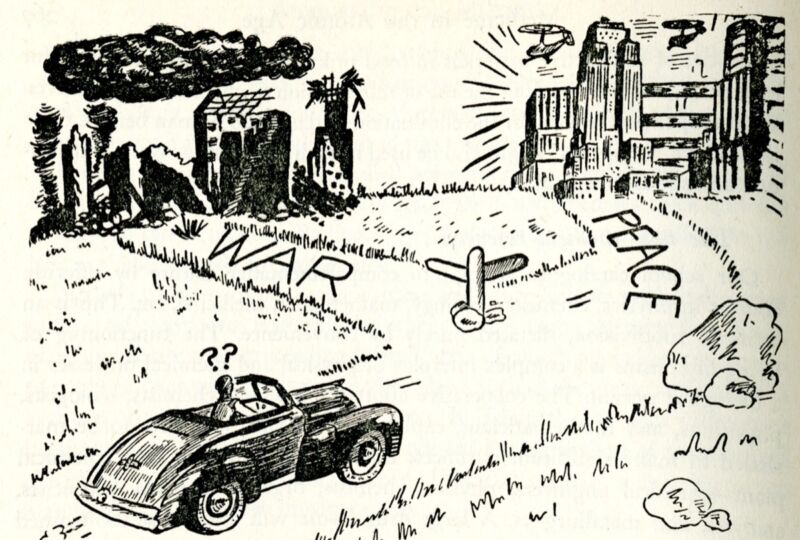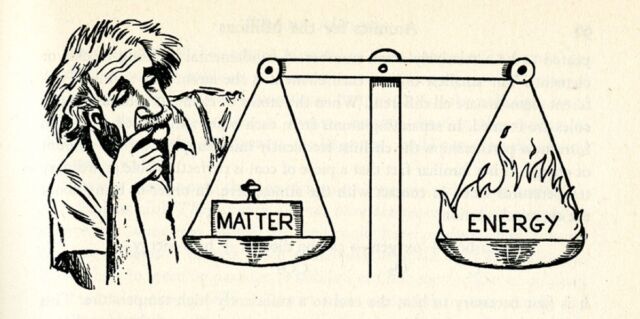
McGraw Hill/Public domain
Beloved American children’s author and illustrator Maurice Sendak probably needs no introduction. His 1963 book, Where the Wild Things Are, is an all-time classic in the picture genre that has delighted generations of kids. It has sold over 19 million copies worldwide, won countless awards, and inspired a children’s opera and a critically acclaimed 2009 feature film adaptation, as well as being spoofed on an episode of The Simpsons.
But one might be surprised to learn (as we were) that a teenage Sendak published his first professional illustrations in a 1947 popular science book about nuclear physics, co-authored by his high school physics teacher: Atomics for the Millions. Science historian Ryan Dahn came across a copy in the Niels Bohr Library & Archives at the American Institute of Physics in College Park, Maryland, and wrote a short online article about the book for Physics Today, complete with scans of Sendak’s most striking illustrations.
Born in Brooklyn to Polish-Jewish parents, Sendak acknowledged that his childhood had been a sad one, overshadowed by losing many extended family members during the Holocaust. That, combined with health issues that confined him to his bed, compelled the young Sendak to find solace in books. When Sendak was 12, he watched Walt Disney’s Fantasia, which inspired him to become an illustrator.
Sendak was well-known in high school for being a talented artist, so it’s perhaps not surprising that his high school physics teacher, Hyman Ruchlis, approached the 18-year-old Sendak about illustrating the nuclear physics book he was writing with a Queens College chemistry professor named Leigh Eidinoff. The intent, per Dahn, was “to demystify nuclear science for laypeople in the wake of the Hiroshima and Nagasaki bombings.” Sendak agreed to do so in exchange for a $100 advance and a small cut (about 1 percent) of the royalties—and (allegedly) a passing grade in his physics class. It was Sendak’s first credited work, and the book has since become a rare collector’s item.

McGraw-Hill/Public domain
Dahn highlights several examples of Sendak’s illustrations for the book. In one, young women represent sodium atoms who meet on the dance floor with young men representing chlorine atoms, resulting in the formation of couples representing sodium chloride molecules. In a chapter entitled “Modern Alchemy,” Sendak illustrated the discussion of nuclear transmutation by depicting Albert Einstein pondering an alchemical balance, with matter on one arm and energy on the other. Nuclear chain reactions are depicted as a deluge of chain letters burying a “harried postal worker.” And rows of radium atoms holding hands and gradually reducing in number over time illustrate the concept of radioactive half-life.
“A perfectionist, Sendak apparently expressed disappointment later in life with his illustrations for the book,” Dahn wrote in his article. “But one can clearly see inklings of the artist’s budding talent in the whimsical drawings, cartoons, and diagrams he created. Along with elucidating concepts from atomic physics, the art also supported the broader claim made by Ruchlis and Eidinoff in the book: With the atomic genie out of the bottle, humanity needed to choose between a peaceful future fueled by nuclear energy and a devastating nuclear war.”
Physics Today, 2024. DOI: 10.1063/pt.auyt.nfrf (About DOIs).




















+ There are no comments
Add yours